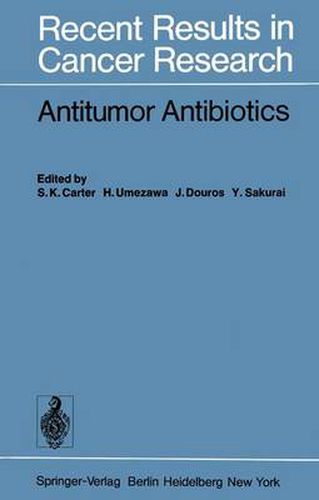Readings Newsletter
Become a Readings Member to make your shopping experience even easier.
Sign in or sign up for free!
You’re not far away from qualifying for FREE standard shipping within Australia
You’ve qualified for FREE standard shipping within Australia
The cart is loading…






This title is printed to order. This book may have been self-published. If so, we cannot guarantee the quality of the content. In the main most books will have gone through the editing process however some may not. We therefore suggest that you be aware of this before ordering this book. If in doubt check either the author or publisher’s details as we are unable to accept any returns unless they are faulty. Please contact us if you have any questions.
The scientific collaboration between the United States and Japan in the field of cancer goes back many years. In this successful international collaboration cancer chemotherapy has been one of the most productive areas. Pioneers such as YOSHIDA, UMEZAWA, SHEAR, and GOLDIN established firm links of mutual trust and respect in the period after the Second Great War. Japanese drugs, such as mitomycin C and bleomycin have become mainstays of clinical oncology in the U. S. and throughout the world. Many drugs developed in the U. S. have become established in Japanese cancer therapy. Within the cancer chemotherapy field the antitumor antibiotics rank as one of the most important groups. In the U . S. -J apanese collaboration this group of drugs has taken the paramount role. The Japanese, under the leadership of U mezawa, are considered to be among the most innovative and productive in this area which has also had great emphasis in the United States as part of the National Cancer Institute’s drug development program and in the pharmaceutical industry. This extended collaboration in general oncology, and chemotherapy in particular, has received increased impetus by and support from the official U . S. -J apan Joint Agreement on cancer research, which was established in 1974 between the National Cancer Institute and the Japanese Society for the Promotion of Science. One of the subsections of this agreement is cancer therapy with emphasis on chemotherapy.
$9.00 standard shipping within Australia
FREE standard shipping within Australia for orders over $100.00
Express & International shipping calculated at checkout
This title is printed to order. This book may have been self-published. If so, we cannot guarantee the quality of the content. In the main most books will have gone through the editing process however some may not. We therefore suggest that you be aware of this before ordering this book. If in doubt check either the author or publisher’s details as we are unable to accept any returns unless they are faulty. Please contact us if you have any questions.
The scientific collaboration between the United States and Japan in the field of cancer goes back many years. In this successful international collaboration cancer chemotherapy has been one of the most productive areas. Pioneers such as YOSHIDA, UMEZAWA, SHEAR, and GOLDIN established firm links of mutual trust and respect in the period after the Second Great War. Japanese drugs, such as mitomycin C and bleomycin have become mainstays of clinical oncology in the U. S. and throughout the world. Many drugs developed in the U. S. have become established in Japanese cancer therapy. Within the cancer chemotherapy field the antitumor antibiotics rank as one of the most important groups. In the U . S. -J apanese collaboration this group of drugs has taken the paramount role. The Japanese, under the leadership of U mezawa, are considered to be among the most innovative and productive in this area which has also had great emphasis in the United States as part of the National Cancer Institute’s drug development program and in the pharmaceutical industry. This extended collaboration in general oncology, and chemotherapy in particular, has received increased impetus by and support from the official U . S. -J apan Joint Agreement on cancer research, which was established in 1974 between the National Cancer Institute and the Japanese Society for the Promotion of Science. One of the subsections of this agreement is cancer therapy with emphasis on chemotherapy.